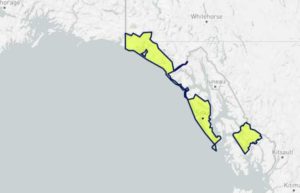
JUNEAU, AK (August 24, 2021) – The Central Council of the Tlingit & Haida Indian Tribes of Alaska (Tlingit & Haida) is one step closer to providing access to improved broadband services in Southeast Alaska. The Federal Communications Commission (FCC) formally accepted Tlingit & Haida’s application for a 2.5 GHz Rural Tribal Priority Window (TPW) license after final review of the requirements for the assignment of the spectrum.
The 2.5 GHz TPW was offered by the FCC in 2019 to all federally recognized tribes where spectrum was available for assignment at no cost. The TPW provided a unique opportunity for tribes in rural areas to gain access to prime mid-band spectrum to deploy broadband and other next-generation wireless services.
According to the FCC, the 2.5 GHz band is suitable for both mobile coverage and fixed point-to-point uses. Known as Educational Broadband Service (EBS), the spectrum was little used, but with advances in technology, it is now positioned to be an important role in the deployment of broadband and other advanced communications services.
|
With a license for use of the 2.5 GHz wireless spectrum, Tlingit & Haida will leverage its spectrum allocation and coming radio broadband deployments to support innovations that will move progressively toward 5G applications. The first initiative will be to deploy 2.5 GHz through new or existing towers to extend fixed wireless internet service to Wrangell customers and continue to establish a customer base with Southeast Alaska tribes for the last-mile delivery of broadband services to communities. “Improving communications services is about improving the general welfare of our tribal citizens,” shared President Richard Chalyee Éesh Peterson. “The COVID-19 pandemic exposed the deficiencies in communications connectivity in Southeast Alaska and it’s the Tribe’s priority to work with village tribes to ensure all communities have high-speed internet. We also want to see better connectivity in outlying land areas and waterways where having communication can be often a matter of life and death.” “The 2.5 GHz spectrum is special,” shared Second Vice President Will Micklin. “This is beachfront property. It’s the sweet spot on the channel where the fish run. This is mid-bandwidth spectrum that provides a strong signal that travels long distances at high speeds with little degradation from obstructions like trees, which is perfect for our rural villages and more dense communities alike. It is also a key building block for future 5G broadband services.” Over the course of the last several months, Tlingit & Haida’s broadband network & systems architects have participated in community visits in Southeast Alaska to share information on the Tribe’s broadband initiative, seek support for the Tribe’s National Telecommunications and Information Administration (NTIA) grant applications, and discuss opportunities to partner with Southeast Alaska village tribes under the 2.5 GHz wireless spectrum. “I am excited to see Tlingit & Haida work with village tribes and use the resources available to remove barriers and close the digital divide in Southeast Alaska,” shared Broadband Network & Systems Architect Chris Cropley. “It’s time our villages are brought to the forefront of the digital age.” Tlingit & Haida’s broadband initiative is to build out fixed wireless towers for the last-mile delivery of broadband services to Southeast Alaska communities; partner with carriers for access and development of broadband to Alaska communities; promote existing options like Emergency Broadband Benefit (EBB); incentivize competition and infrastructure, offer local support for networking and computing; make cybersecurity more accessible; and provide education, endpoints, Customer Premise(s) Equipment (CPE), security, managed networking and local technical support to effectively utilize the internet for governance, education, healthcare, public safety and law enforcement, and economic development. |
|
### |
